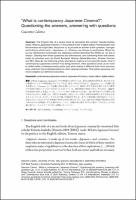Chapter “What is contemporary Japanese Cinema?”. Questioning the answers, answering with questions
| dc.contributor.author | CALORIO, GIACOMO | |
| dc.date.accessioned | 2022-06-01T12:18:07Z | |
| dc.date.available | 2022-06-01T12:18:07Z | |
| dc.date.issued | 2020 | |
| dc.identifier | ONIX_20220601_9788855182607_465 | |
| dc.identifier.issn | 2704-5919 | |
| dc.identifier.uri | https://library.oapen.org/handle/20.500.12657/56282 | |
| dc.description.abstract | The English title of a recent book by renowned film scholar Yomota Inuhiko reads: “What is Japanese Cinema?”. In the preface to the English edition Yomota states that the direction we might take, should we try to provide an answer to the question, changes according to which word, “Japanese” or “Cinema” we choose to emphasize. When his survey reaches the recent past, the Japanese scholar describes the 2000s as “an era of chaos”. Starting from these questions and affirmations, and combining them with others made by scholars such as David Bordwell, Mitsuyo Wada-Marciano, Andrew Dorman and Mori Naoyuki, the following article attempts to explore a more specific doubt: “What is contemporary Japanese cinema”? In so doing, however, other questions arise, as we need to define when contemporaneity starts and what makes it different both from previous eras, and from the contemporaneity of other national cinemas. The further we probe, the more complex our definition becomes. | |
| dc.language | English | |
| dc.relation.ispartofseries | Studi e saggi | |
| dc.subject.other | contemporary Japanese cinema | |
| dc.subject.other | Japanese film theory | |
| dc.subject.other | visual culture | |
| dc.subject.other | digital culture | |
| dc.title | Chapter “What is contemporary Japanese Cinema?”. Questioning the answers, answering with questions | |
| dc.type | chapter | |
| oapen.identifier.doi | 10.36253/978-88-5518-260-7.01 | |
| oapen.relation.isPublishedBy | bf65d21a-78e5-4ba2-983a-dbfa90962870 | |
| oapen.relation.isbn | 9788855182607 | |
| oapen.series.number | 220 | |
| oapen.pages | 17 | |
| oapen.place.publication | Florence |

